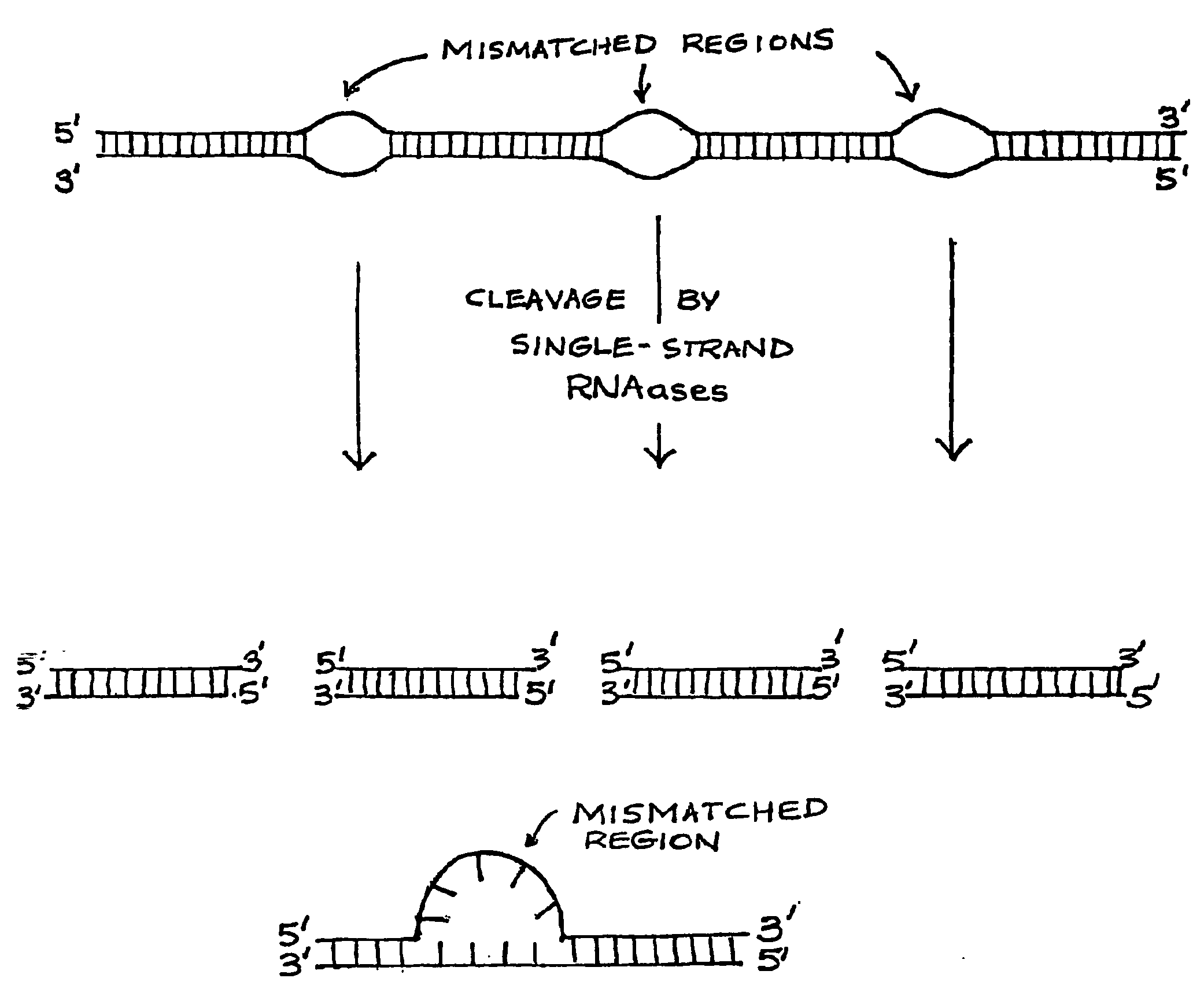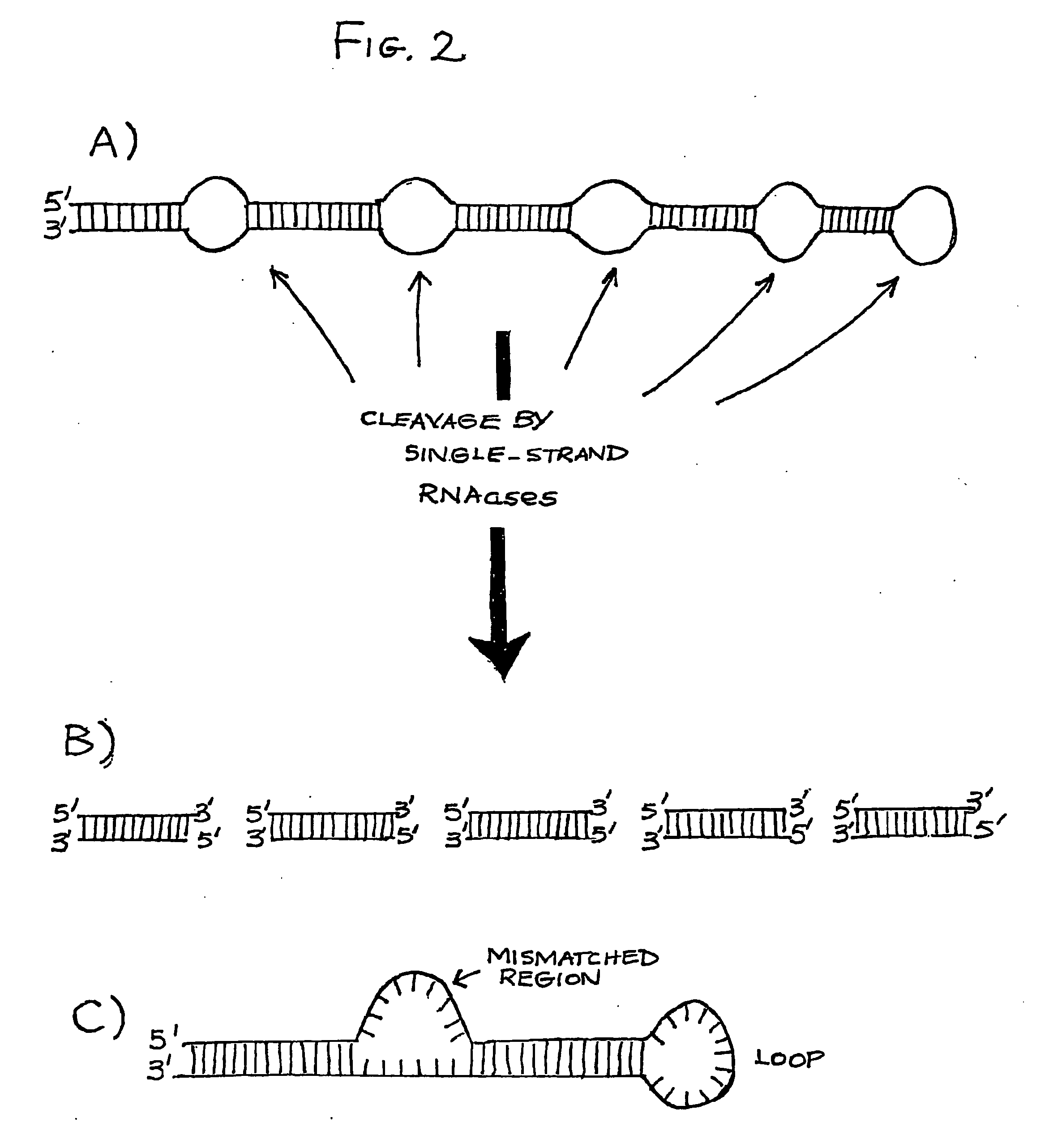Double-stranded rna structures and constructs, and methods for generating and using the same
a double-stranded rna and construct technology, applied in the field of dsrna structures and dsrna expression constructs, can solve the problems of rapid dsrna-mediated stress response, unusable non-specific cytotoxicity or cell death, and cellular apoptosis or anti-proliferation effects
- Summary
- Abstract
- Description
- Claims
- Application Information
AI Technical Summary
Benefits of technology
Problems solved by technology
Method used
Image
Examples
example 1
Transcriptional and Post-Transcriptional Gene Silencing
[0196] Transcriptional gene silencing (TGS) is a phenomenon in which silencing of gene expression occurs at the level of RNA transcription. Double-stranded RNA mediates TGS as well as post-transcriptional gene silencing (PTGS), but the dsRNA needs to be located in the nucleus, and desirably is made in the nucleus in order to mediate TGS. PTGS occurs in the cytoplasm. A number of dsRNA structures and dsRNA expression vectors have been delineated herein that can mediate TGS, PTGS, or both. Various strategies for mediating TGS, PTGS, or both are summarized below.
[0197] All of the cytoplasmic dsRNA expression vectors described herein mediate PTGS because they generate dsRNA in the cytoplasm where the dsRNA can interact with target mRNA. Because some of the dsRNA made by these vectors translocate to the nucleus via a passive process (e.g., due to nuclear envelope degeneration and reformation during mitosis), these vectors are also ...
example 2
Exemplary Methods for Enhancing Post-Transcriptional Gene Silencing
[0202] To enhance PTGS by dsRNA transcribed in the nucleus by RNA Po1II, one or more introns and / or a polyadenylation signal can be added to the dsRNA to enable processing of the transcribed RNA. This processing is desirable because both splicing and polyadenylation facilitate export from the nucleus to the cytoplasm. In addition, polyadenylation stabilizes RNA Po1II transcripts. In some embodiments, a prokaryotic antibiotic resistance gene, e.g., a zeomycin expression cassette is located in the intron. Other exemplary prokaryotic selectable markers include other antibiotic resistance genes such as kanamycin, including the chimeric kanamycin resistance gene of U.S. Pat. No. 5,851,804, aminoglycosides, tetracycline, and ampicillin. The zeomycin gene is under the regulatory control of a prokaryotic promoter, and translation of zeomycin in the host bacterium is ensured by the presence of Shine-Dalgarno sequences locate...
example 3
Exemplary Methods for the Generation of dsRNA In Vivo
[0212] Exemplary intracellular expression systems for sustained expression of dsRNA include cytoplasmic expression systems, e.g., a T7 promoter / T7 RNA polymerase, mitochondrial promoter / mitochondrial RNA polymerase, or RNA polII expression system. Other possible cytoplasmic expression systems use exogenously introduced viral or bacteriophage RNA polymerases and their cognate promoters or endogenous polymerases such as the mitochondrial RNA polymerase with their cognate promoters. In another embodiment, the sustained long dsRNA intracellular expression system is a nuclear expression system, such as an RNA poll, RNA polII, or RNA polIII expression system.
[0213] Expression in eukaryotic cells is complicated by the existence of subcellular compartments, including functional compartments. This results in a situation where populations of expression constructs (frequently, the majority of the expression constructs which make it into th...
PUM
| Property | Measurement | Unit |
|---|---|---|
| Length | aaaaa | aaaaa |
| Atomic weight | aaaaa | aaaaa |
| Biological properties | aaaaa | aaaaa |
Abstract
Description
Claims
Application Information
 Login to View More
Login to View More - R&D
- Intellectual Property
- Life Sciences
- Materials
- Tech Scout
- Unparalleled Data Quality
- Higher Quality Content
- 60% Fewer Hallucinations
Browse by: Latest US Patents, China's latest patents, Technical Efficacy Thesaurus, Application Domain, Technology Topic, Popular Technical Reports.
© 2025 PatSnap. All rights reserved.Legal|Privacy policy|Modern Slavery Act Transparency Statement|Sitemap|About US| Contact US: help@patsnap.com



